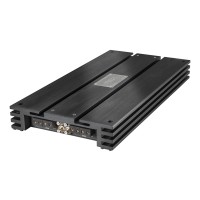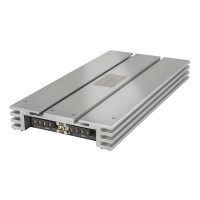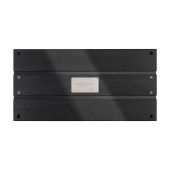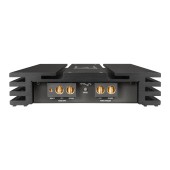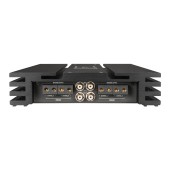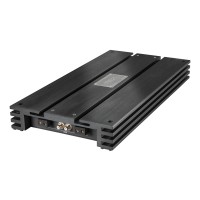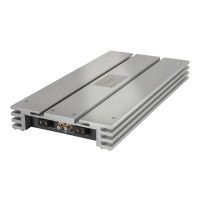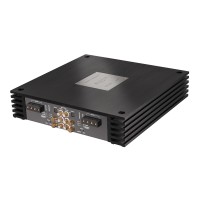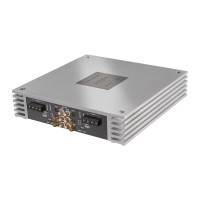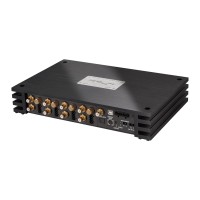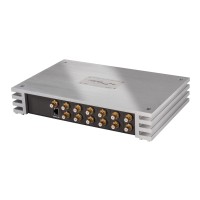Amplifier Brax GX2400 Black
More about the product
- You can return the goods to us within 14 days
Amplifier Brax GX2400 Black
With the first BRAX X2000 and X2400 amplifiers, Brax set a milestone in the history of high-end car audio. Now the brand new successors BRAX GX2000 and BRAX GX2400 ignite an exciting new era of audiophile innovation. Both amplifiers combine an elegant, purist design with state-of-the-art Class AB technology. This generation comes without any crossovers and filter functions. The sophisticated layout of the printed circuit board combined with short signal paths and hand-selected components "made in Germany" ensure a pristine listening experience and underline the purist design as well as the top philosophy of amplifiers and the most demanding audiophiles. In order to achieve their high quality standards at Brax, they use only hand-selected transistors for the production of each GX amplifier to avoid even the smallest deviations in performance, on the contrary, they can eliminate the need for manufacturing tolerances, because perfection is the only acceptable tolerance. Transistors are classified into more than 300 categories; this is possible due to our own developed measuring equipment, it is really that important to us! In addition, the fixed terminals, which are gold-plated, accommodate cables up to 50 mm², as well as a separate terminal for connecting the BRAX IPC capacitor directly to the switching transistors. Simply put, the GX2000 and GX2400 can only be described as truly high-end amplifiers for accurate and natural sound reproduction. Each amp is available in black or silver, with either a short or extended heatsink.
The main features of the Brax GX2400 amplifier
- Low connection resistance thanks to solid gold-plated terminals for power cables up to 50 mm² and speaker cables up to 6 mm².
- A separate terminal for connecting the IPC BRAX directly to the switching transistors.
- Signal inputs with top signal capacitors for perfect and clean sound quality.
- Each amp is available in black or silver with either a short or extended heatsink.
- Specially developed transformers with high-efficiency core materials guarantee a total output power of more than 1,000 watts.
- Massive cooler made of a special aluminum alloy for perfect cooling of transistors in the power supply and output stage.
- 32 hand-picked high-end MOSFET transistors for brilliant sound.
- The level controls for adjusting the input sensitivity are located below the nameplate, giving the amplifier a clean and purist design.
- Adjustment range 1.0V to 8.0V.
- Handmade in Germany.
| Catalog number | BRAX GX2400 BLACK LONG |
| Brand | Brax |
| Links | Official web presentation |
| Number of amplifier channelsAmplifiers are divided into: - Monoblocks - 2-channel - 3-channel - 4-channel - 5-channel - 6-channel - multi-channel Each channel is used to power one speaker for the coaxial type, or one side if they are component speakers. Monoblock type amplifiers are mainly used for subwoofers. 2-channel are suitable for both subwoofers and, for example, the front pair of speakers in a car. 3-channel is used for front or rear speakers + subwoofer. 4-channel are used for front + rear speakers or 1 pair of speakers + subwoofer. 6 or 5-channel are used for 2 pairs of speakers + subwoofer, most often. Bridging means connecting the amplifier to a bridge, using the + pole from one channel and the - pole from the other channel. In most cases this is shown as "BRIDGED" on the amplifier. | 4 |
| Energy class of the amplifierAmplifiers are divided into two basic classes: analog and digital . Analog amplifiers (A/B) have higher consumption requirements, but usually have a more natural sound. Digital amplifiers (D) have significantly lower consumption and higher efficiency, but the sound may not be as faithful as with classic analog amplifiers. | A/B |
| RMS power into 4 ΩRMS power when loading speakers or subwoofer at 4 Ω. RMS power is the constant power of the amplifier and is one of the most important parameters when choosing an amplifier. | 4 x 150 / 2 x 480 W |
| RMS power into 2 ΩRMS power when loading speakers or subwoofer at 2 Ω. RMS power is the constant power of the amplifier and is one of the most important parameters when choosing an amplifier. | 4 x 240W |
| Inputs | 4 x RCA |
| Outputs | 4 x speaker |
| Frequency rangeThe ability of the amplifier to reproduce the signal from the lowest frequency to the highest = faithfully reproduce the sound in a specific frequency band. Professionally: In the frequency range from 40 to 16,000 Hz, the vast majority of fundamental and overtones (harmonics) of all musical instruments are found. We are interested in the course of the radiated sound pressure in this range of frequencies when the loudspeaker system is supplied with constant power. We call this course the frequency characteristic, which tells us the level of radiated sound pressure in decibels (dB) depending on the frequency. The frequency characteristic of a speaker or speaker system can be expressed most succinctly with a graph. Mostly, however, the frequency characteristic is indicated by indicating the maximum tolerance of the sound pressure in the given frequency range, e.g. 50 to 15,000 Hz -+ 6 dB. Since the frequency characteristics of loudspeakers and systems in general are quite uneven, some manufacturers do not even specify this maximum tolerance of sound pressure in decibels in their catalogs for reasons of prestige. Data impoverished in this way is unfortunately worthless. What is valid is that the manufacturer offers a speaker system with a frequency range of 30 to 20,000 Hz, if he is worried about stating the maximum unevenness of the sound pressure in this range, because he can have a tolerance of, for example, +- 20 dB. The unevenness or undulation of the frequency curve in good speaker systems for high-quality music performance should not exceed +-3 dB in the 80 to 12,000 Hz band and +-6 dB in the 40 to 16,000 Hz band. Greater unevenness already depletes or emphasizes certain tonal areas, which can cause audible or even disturbing distortion. The proportion between fundamental tones and higher harmonics also changes, thereby changing the color of the sound, and individual musical instruments as well as the entire musical image sound unnatural. | 10 - 80000 Hz |
| Harmonic Distortion (THD)Total harmonic distortion indicates how much the input signal is distorted in the amplifier. Distortions appear as overtones contained in the output signal. The proportion of originally absent parts of the signal is given as a percentage, typical values are between 0.001% and 0.5%. Distortion is measured in their power band. If it exceeds the limit of 0.7% from a certain power, it is the value of the output power of the given amplifier, from which it no longer plays without distortion and from which the distortion usually increases steeply, so that no further increase in power can be counted on. The lower the value, the better. | < 0.0008% |
| Signal-to-noise ratioThe signal-to-noise ratio means that the output signal always contains noise. The signal-to-noise ratio expresses how much of this noise is compared to the useful signal. The so-called A value is given, which does not take deep and very high frequencies into account. This corresponds to the characteristic of human hearing, which is not so sensitive to deep frequencies, especially below 1 kHz. The higher the value, the better the amplifier is. | > 120 dB |
| Input sensitivityIn order for the amplifier to perform its function correctly, it requires an input signal of a certain level, which is different for car radios. It is measured in "Volts" (e.g. 2 V, 4 V, etc.) The higher the value at the output of the pre-amplifier, or car radio, the less demands are placed on the power of the amplifier. However, the amplifier must allow this input sensitivity, and for that reason this value is also given for the amplifier. | 1 - 8 V |
| The value of the fuses on the amplifierFrom the value of the fuses on the amplifier, you can get a true picture of the real performance of the amplifier. | 4 x 30A |
| Dimensions of the amplifier | 53 x 237.5 x 473 mm |
| Mass | 8.6 Kg |
